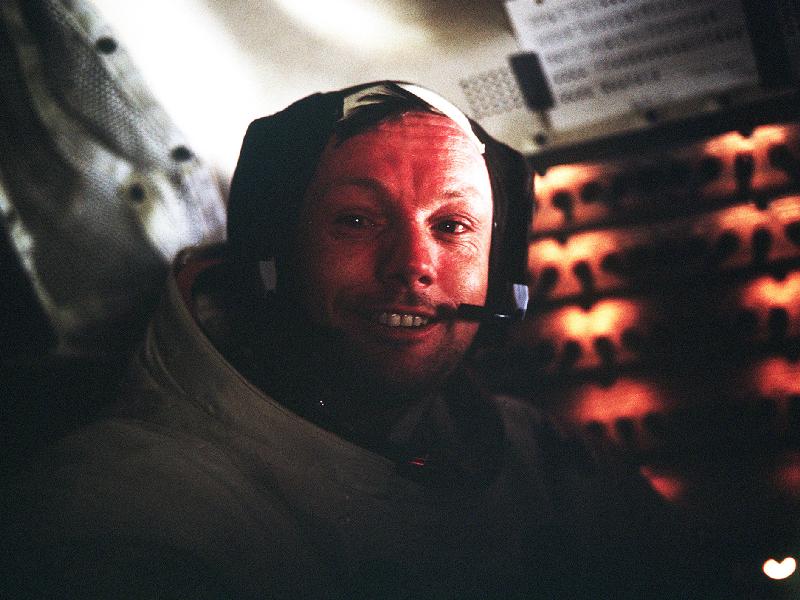SUMMARY
This is AI generated summarization, which may have errors. For context, always refer to the full article.
WASHINGTON DC, United States of America – With one small step off a ladder, Neil Armstrong became the first human to set foot on the moon on July 20, 1969, making him the most lauded American of the Cold War space race.
With that step, Armstrong, whose death was announced Saturday, August 25 (Sunday, August 26 in Manila), became an instant hero — a status he would struggle to reckon with throughout his life.
His first words upon stepping on the lunar surface have since been etched in history: “That’s one small step for (a) man, one giant leap for mankind.”
An estimated 500 million people watched the grainy black and white broadcast that showed Armstrong, clad in a white space suit, step gingerly on to the moon’s desolate surface.
As commander of the Apollo 11 mission, it was also Armstrong who had notified mission control of the module’s successful landing. “Houston, Tranquility base here. The Eagle has landed,” he said.

Joined by fellow astronaut Buzz Aldrin, Armstrong spent about two and a half hours exploring the landscape around the landing site, describing the surface as being like powdered charcoal.
He and Aldrin bounced gracefully in slow-motion despite their clumsy space suits, getting a first feel for the moon’s gravity, which is one sixth that of Earth.
The two moonwalkers took photographs, collected rock and soil samples and deployed scientific instruments.
They also planted a US flag and placed a plaque stating: “Here men from the planet Earth first set foot upon the moon. We came in peace for all mankind.”
The then US president Richard Nixon marked the occasion in what he described at the time as “the most historic telephone call ever made.”
“For every American, this has to be the proudest day of our lives,” Nixon told Armstrong and Aldrin.
The astronauts returned to Earth on July 24, ending the celebrated Apollo 11 mission, Armstrong’s second and last venture into space.
In September 1966, Armstrong had flown with David Scott on the Gemini 8 mission that linked up with the unmanned Agena Target Vehicle in the first ever docking of two spacecraft.
From Ohio to the Moon
Born in Wapakoneta, Ohio on August 5, 1930, Armstrong had an early fascination with aircraft and worked at a nearby airport when he was a teenager.
He took flying lessons at the age of 15 and received his pilot’s license on his 16th birthday.
A US Navy aviator, he flew 78 missions in the Korean War.
He studied Aeronautical Engineering at Purdue University in Indiana, and later earned a Master of Science degree in Aerospace Engineering at the University of Southern California.
In 1955, he became a test pilot at the High-Speed Flight Station at Edwards Air Force Base in California, where he flew about 50 different types of aircraft.
Seven years later, Armstrong was selected by the National Air and Space Administration to train as an astronaut in Houston, Texas.
Away from the limelight
After retiring from NASA in 1971, Armstrong taught aerospace engineering at the University of Cincinnati for nearly a decade and served on the boards of several companies, including Lear Jet, United Airlines and Marathon Oil.
Despite his worldwide fame, the lunar pioneer shied away from the limelight.
In a rare interview, Armstrong told the CBS network in 2005, he did not deserve the attention he received for being the first man on the moon.
“I wasn’t chosen to be first. I was just chosen to command that flight. Circumstance put me in that particular role,” he said.
For decades, Armstrong was thought to have flubbed the first words spoken by man on the moon, by dropping the “a” when speaking of a small step “for man.”
But 37 years after the lunar landing, an Australian expert said a high-tech analysis of the static-ridden transmission from the moon found the missing “a”, and said the dramatic phrase should be restored to the grammatically correct “That’s one small step for a man, one giant leap for mankind.”
The iconic space explorer also denied claims by conspiracy theorists that the lunar landing was a giant hoax or that he became a Muslim after hearing the Islamic call to prayer on the moon. – Agence France-Presse
Add a comment
How does this make you feel?
There are no comments yet. Add your comment to start the conversation.